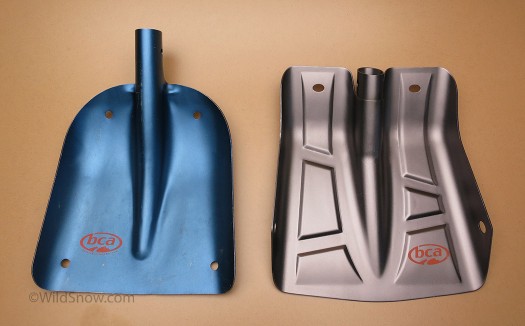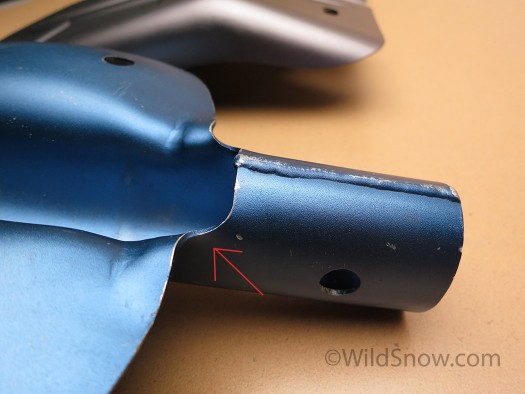Shovels are arguably one of the most important pieces of avy gear we carry. It’s virtually impossible to perform a rescue without one. Unfortunately the rescue aspect is entirely reactive — hopefully something I won’t ever have to test. However, the myriad of other uses for shovels make them stand out as a backcountry tool. Digging snow pits, tent platforms, snow anchors, etc., make the shovel a BC multi-tool. My shovel seems to come out of the pack on almost every tour.
I’ve used BCA shovels for years. They’ve always been solid and simple. Older model BCAs however, had a weak point in their method of attaching the handle, using a circle bent out of the metal of the blade. The same technique is used by lots of other shovel manufactures, probably including the one that makes your gardening shovel. I’ve heard about this being a potential weak point but it always seemed like a small issue; unlikely to actually explode.
Indeed, according to BCA the rate of breakage for the older model shovels was tiny, and over the years there have no doubt been hundreds of rescues performed with BCA shovels. However, this summer in South America, my older model broke. I was digging a pit through a super hard rain layer, and SNAP, the shovel handle popped off the blade. I was amazed at how easy it broke and immediately decided to get a new, stronger, shovel the first chance I got.

Old style BCA shovel on the left, new on the right. Big difference. The new shovel is stronger, and has more surface area, while still being the same weight, and takes up less space. Cool!
So after numerous and sometimes ludicrous South American shovel solutions, upon my return to the states I picked up a new BCA B2 shovel. With their “B” models BCA has updated their shovels significantly with stronger construction and a few extra features. Their Bomber line of shovels features a welded tube that holds the handle. This means that there’s twice as much material that has to break, making the connection much stronger. The new system also makes the shovel pack a bit better, since the handle attachment doesn’t protrude out. The new shovel also features a square top, which increases the surface area, and provides a flat area to push on with your foot. A few other new features are stiffening ribs on the shovel blade and an updated handle. They retained their standard ovalized handle, so it is backwards compatible with older shovel handles. I have a heavier handle with an integrated saw that I use in the winter, and a lighter one that I use for spring or low-danger tours.

The BCA handle is interesting. It's designed to be held like this, rather than with split fingers like a normal T-grip. Several other companies have moved to this style of grip as well.
I’ve been using the Bomber shovel all winter. It’s been working perfectly. Beyond plenty of strength, the pack-ability is the most noticeable improvement. One other problem I’ve experienced with shovels in the past is snow plugging the shaft, either making the shovel heavy, or making the pins not work. BCA included a small plastic plug in the end of the handle that solves this issue. I haven’t encountered any situations that really tested the strength of the shovel, but it is holding up well.
BCA shovels use an oval handle, making it easy to line up the pins with the holes when assembling the shovel. An unfortunate by-product of the design is that it tends to bind up, especially with snow and ice. This isn’t really a safety issue, because it only gets stuck when it is assembled, but it’s a bummer when you can’t bifurcate the shovel from its handle.
It appears most shovel manufacturers have switched to using a similar method of construction, a great thing to see. With so many companies changing their products every year for no apparent reason, it’s nice to see some real improvement. The B2 shovel is a nice example of good design and engineering improving a product without creating any undesirable compromises.
Shop for the BCA B2 shovel here
Louie Dawson earned his Bachelor Degree in Industrial Design from Western Washington University in 2014. When he’s not skiing Mount Baker or somewhere equally as snowy, he’s thinking about new products to make ski mountaineering more fun and safe.



